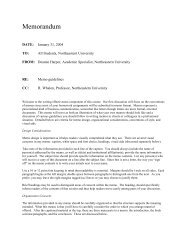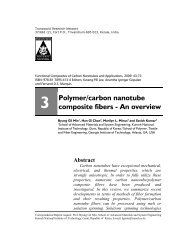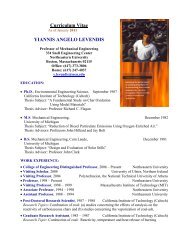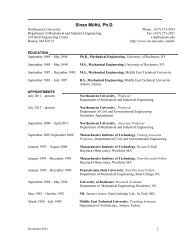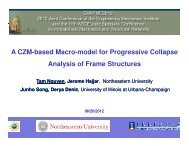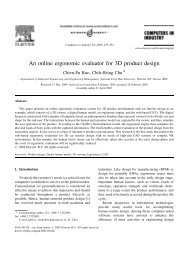Create successful ePaper yourself
Turn your PDF publications into a flip-book with our unique Google optimized e-Paper software.
simplified versions of these formulas are shown. The equations are<br />
functions of the properties of the headed steel anchors, including<br />
height, shank diameter, <strong>and</strong> concrete strength. The proposed<br />
formulas have been calibrated using a least squares technique,<br />
constraining the average test-to-predicted ratio to equal 1.0 for<br />
all 114 tests failing in the concrete (Fig. 5). The statistical values<br />
for optimized formulas <strong>and</strong> then their corresponding simplified<br />
formulas developed to predict concrete failures of anchors loaded<br />
in shear in composite construction are shown in Table 7.<br />
Proposals 1 <strong>and</strong> 2 have the same form as the current formula<br />
of AISC <strong>and</strong> EC-4, without distinguishing the concrete weight.<br />
Proposal 3 takes into account the stud height, similar to PCI<br />
6th Edition <strong>and</strong> ACI 318-08. Proposal 4 takes into account<br />
the concrete weight (λ), with the result being similar to one<br />
�proposed by Anderson <strong>and</strong> Meinheit [4]. The coefficient λ =<br />
f<br />
′<br />
�<br />
1<br />
≤ 1.0 (in psi) or λ =<br />
≤ 1.0<br />
c,sp<br />
6.7<br />
� 1<br />
√f ′<br />
c<br />
L. Pallarés, J.F. <strong>Hajjar</strong> / Journal of Constructional Steel Research 66 (2010) 198–212 205<br />
Fig. 3. Steel failure formulas in comparison with steel failure in tests.<br />
� f ′<br />
c,sp<br />
0.046<br />
√<br />
f<br />
′<br />
c /0.0069<br />
(in MPa) is a lightweight concrete factor. It can be computed<br />
following either ACI 318-08 or PCI 6th Edition. If the value<br />
of the splitting tensile strength f ′<br />
c,sp is not known, λ equals<br />
0.85 for s<strong>and</strong>–lightweight concrete <strong>and</strong> 0.75 for all-lightweight<br />
concrete. Lightweight concrete according to ACI 318-08 is concrete<br />
containing lightweight aggregate <strong>and</strong> having a density between<br />
90 lb/ft 3 (1440 kg/m 3 ) <strong>and</strong> 115 lb/ft 3 (1840 kg/m 3 ).<br />
Table 7 shows the resistance factors (φ) for reliability indices<br />
of 3 <strong>and</strong> 4 for the tests that failed by the concrete. It can be<br />
seen that all four proposals result in similar resistance factors,<br />
equaling approximately 0.60 for a reliability index of 4 <strong>and</strong> 0.70<br />
for a reliability index of 3.<br />
7. Headed steel stud shear strength for hef /d > 4.5<br />
From the earliest tests carried out by Viest [7], it has been seen<br />
that hef /d is a significant parameter that often delineates the type<br />
of failure that occurs in tests that do not have free edge conditions.<br />
In the tests by Viest [7], for example, the failure normally occurred<br />
in the steel stud when hef /d was larger than 4.53. Driscoll <strong>and</strong><br />
Slutter [8] observed that, if h/d was greater than 4.2, they could<br />
develop all the strength in tension (i.e., AsFu) rather than shear, <strong>and</strong><br />
the tensile strength then determined the ultimate strength of the<br />
studs in their push-out tests. It was further noted that, for studs<br />
shorter than h/d = 4.2, the strength must be reduced because of<br />
the possibility of the ultimate strength being reduced by fracture<br />
of the concrete. Ollgaard et al. [15] tested studs with an effective<br />
embedment depth of 3.50 <strong>and</strong> 4.20. They indicated that in many<br />
tests both steel <strong>and</strong> concrete failures were observed in the same<br />
specimen.<br />
A summary of failures found in the tests in the database<br />
classified as having studs that are greater than or less than a given<br />
hef /d ratio (including ratios of 4.00, 4.50, 5.50, <strong>and</strong> 6.50) is given<br />
in Table 8. AISC [30] states that headed steel studs shall not be<br />
less than four stud diameters in length after installation <strong>and</strong> EC-<br />
4 applies a reduction factor on the stud strength for ratios of h/d<br />
between 3 <strong>and</strong> 4. Recognizing the h/d limitation in AISC [30] <strong>and</strong><br />
assuming that h is a few percent larger than hef to account for the<br />
depth of the stud head, it can be reasoned that for a headed stud<br />
whose h/d value is right at the limit, approximately 73% of the<br />
failures are likely to occur in the steel. In contrast, 81% of the tests<br />
having a ratio hef /d larger than 4.50 failed in the steel, <strong>and</strong> 91%<br />
failed in the steel for hef /d larger than 5.50.<br />
Based on these results, if the minimum h/d ratio limit of 4 in<br />
AISC [30] is recommended for increase to 5 (i.e., hef /d equaling<br />
4.5 for a 3/4 in (19 mm) diameter headed stud having a 3/8<br />
in (9.5 mm) depth of the head), 81% of the 224 tests with ratios<br />
larger than this limit failed in the steel. In order to predict the<br />
failure of the remaining 19% of the tests that failed in the concrete,<br />
one of the proposed formulas in the prior section could be used,<br />
taking the minimum value of steel <strong>and</strong> concrete failures. However,<br />
as discussed below, checking the steel formula alone may be<br />
adequate for this minimum ratio of hef /d.<br />
The required resistance factor for headed studs with hef /d ratios<br />
larger than 4 <strong>and</strong> 4.5 is presented in Table 9. Fig. 5 then plots the<br />
test-to-predicted ratios, separating tests based on their value of<br />
hef /d. Also, in these plots, both the measured material strengths



